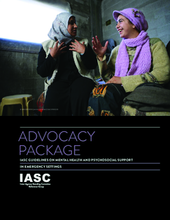The IASC Guidelines on Mental Health and Psychosocial Support in Emergency Settings (IASC, 2007) help to plan, establish and coordinate a set of minimum multi-sectoral responses to protect and improve people’s Mental Health and psychosocial well-being in the midst of an emergency. The Guidelines can be used as (i) a Guide for programme planning and design; (ii) advocacy for better practice; (iii) resource for interventions or actions; (iv) coordinating tool; and (v) checklist to identify gaps.
The IASC MHPSS Guidelines clarify that Mental Health and psycho-social support requires various levels of supports, ranging from broad programmes on basic services and security issues, to community and family support interventions and focused or specialized Mental Health services. It is therefore necessary to distinguish between interventions that benefit the population at large from those interventions requiring a more specialized expertise.
As part of the annual review of the IASC MHPSS Guidelines implementation increasing the ownership and utilization of the IASC MHPSS Guidelines by governments was identified as a priority to ensure its success. In addition, conducting advocacy on the importance of MHPSS issues within the UN system was also a priority. A campaign was initiated to raise further awareness of and commitment to the IASC MHPSS Guidelines by governments.
The objective of this campaign is to encourage all humanitarian actors and UN Member States affected by or at risk of emergencies, to embrace and implement the IASC MHPSS Guidelines, and to highlight the progress made by countries that already implemented them. The initiative is being co-sponsored by UNICEF representing the IASC Mental Health and Psychosocial Reference Group and the Permanent Representation of Belgium to the UN. The campaign was launched with an event in October 2010 in New York.
This Advocacy Package explains what the guidelines are and how they are to be used, highlights the key campaign activities, key messages for communities, donors, UN Agencies and Non-Governmental organisations, clarifies terminology and provide ideas for country level implementation.

